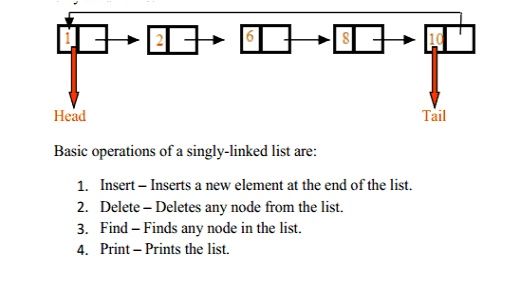Chapter: Programming and Data Structures : Linear Data structures- List
Circularly linked lists
CIRCULAR LINKED LIST
In circular linked list the pointer of the last node
points to the first node. Circular linked list can be implemented as Singly
linked list and Doubly linked list with or without headers.
Advantages of Circular Linked List
It allows to traverse the list starting
at any point.
It allows quick access to the first and
last records.

C PROGRAM FOR CIRCULAR LINKED LISTS
#include <stdio.h> #include
<stdlib.h>
struct
node
{
int
data;
struct
node *next;
};
struct
node *head = NULL, *tail = NULL;
struct node * createNode(int data) {
struct node *newnode;
newnode = (struct node *)malloc(sizeof (struct
node)); newnode->data = data;
newnode->next
= NULL;
}
/*
* create
dummy head and tail to make
* insertion
and deletion operation simple.
* While
processing data in our circular
* linked
list, skip these dummies.
*/
void createDummies() { head =
createNode(0); tail = createNode(0); head->next = tail; tail->next =
head;
}
/* insert data next to dummy head */ void
circularListInsertion(int data) { struct node *newnode, *temp; newnode =
createNode(data);
temp = head->next; head->next =
newnode; newnode->next = temp;
}
/* Delete the node that has the given data */ void
DeleteInCircularList(int data) {
struct
node *temp0, *temp;
if (head->next == tail &&
tail->next == head) { printf("Circular Queue/list is empty\n");
}
temp0 = head; temp = head->next;
while
(temp != tail) {
if (temp->data == data) {
temp0->next = temp->next; free(temp);
break;
}
temp0 = temp; temp = temp->next;
}
return;
}
/*
* travese
the circular linked list for
* the
given no of times.
*/
void display(int count) { int n = 0;
struct
node *tmp = head;
if (head->next == tail &&
tail->next == head) { printf("Circular linked list is empty\n");
return;
}
while
(1) {
/* skip the data in dummy head and tail */ if (tmp
== head || tmp == tail) {
if (tmp == tail) {
n++;
printf("\n");
if (n == count) break;
}
else {
tmp = tmp->next; continue;
}
}
else {
printf("%-3d",
tmp->data);
}
tmp
= tmp->next;
}
return;
}
int
main()
{
int data, ch, count; createDummies(); while (1) {
printf("1. Insertion\t2. Deletion\n");
printf("3. Display\t4. Exit\n"); printf("Enter ur
choice:"); scanf("%d", &ch);
switch (ch) { case 1:
printf("Enter the data to insert:");
scanf("%d", &data); circularListInsertion(data); break;
case
2:
printf("Enter the data to delete:");
scanf("%d", &data); DeleteInCircularList(data); break;
case
3:
printf("No of time u wanna traverse:");
scanf("%d", &count);
display(count);
break;
case
4:
exit(0);
default:
printf("Pls. enter correct option\n");
break;
}
}
return
0;
}
Related Topics